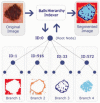A soft kinetic data structure for lesion border detection
- PMID: 20529909
- PMCID: PMC2881363
- DOI: 10.1093/bioinformatics/btq178
A soft kinetic data structure for lesion border detection
Abstract
Motivation: The medical imaging and image processing techniques, ranging from microscopic to macroscopic, has become one of the main components of diagnostic procedures to assist dermatologists in their medical decision-making processes. Computer-aided segmentation and border detection on dermoscopic images is one of the core components of diagnostic procedures and therapeutic interventions for skin cancer. Automated assessment tools for dermoscopic images have become an important research field mainly because of inter- and intra-observer variations in human interpretations. In this study, a novel approach-graph spanner-for automatic border detection in dermoscopic images is proposed. In this approach, a proximity graph representation of dermoscopic images in order to detect regions and borders in skin lesion is presented.
Results: Graph spanner approach is examined on a set of 100 dermoscopic images whose manually drawn borders by a dermatologist are used as the ground truth. Error rates, false positives and false negatives along with true positives and true negatives are quantified by digitally comparing results with manually determined borders from a dermatologist. The results show that the highest precision and recall rates obtained to determine lesion boundaries are 100%. However, accuracy of assessment averages out at 97.72% and borders errors' mean is 2.28% for whole dataset.
Figures
Similar articles
-
Analysis of density based and fuzzy c-means clustering methods on lesion border extraction in dermoscopy images.BMC Bioinformatics. 2010 Oct 7;11 Suppl 6(Suppl 6):S26. doi: 10.1186/1471-2105-11-S6-S26. BMC Bioinformatics. 2010. PMID: 20946610 Free PMC article.
-
Density-based parallel skin lesion border detection with webCL.BMC Bioinformatics. 2015;16 Suppl 13(Suppl 13):S5. doi: 10.1186/1471-2105-16-S13-S5. Epub 2015 Sep 25. BMC Bioinformatics. 2015. PMID: 26423836 Free PMC article.
-
An improved border detection in dermoscopy images for density based clustering.BMC Bioinformatics. 2011 Oct 18;12 Suppl 10(Suppl 10):S12. doi: 10.1186/1471-2105-12-S10-S12. BMC Bioinformatics. 2011. PMID: 22166058 Free PMC article.
-
Deep Learning Approaches Towards Skin Lesion Segmentation and Classification from Dermoscopic Images - A Review.Curr Med Imaging. 2020;16(5):513-533. doi: 10.2174/1573405615666190129120449. Curr Med Imaging. 2020. PMID: 32484086 Review.
-
Lesion border detection in dermoscopy images.Comput Med Imaging Graph. 2009 Mar;33(2):148-53. doi: 10.1016/j.compmedimag.2008.11.002. Epub 2009 Jan 3. Comput Med Imaging Graph. 2009. PMID: 19121917 Free PMC article. Review.
Cited by
-
Skin Lesion Segmentation in Dermoscopic Images with Combination of YOLO and GrabCut Algorithm.Diagnostics (Basel). 2019 Jul 10;9(3):72. doi: 10.3390/diagnostics9030072. Diagnostics (Basel). 2019. PMID: 31295856 Free PMC article.
-
Skin Lesion Segmentation with Improved Convolutional Neural Network.J Digit Imaging. 2020 Aug;33(4):958-970. doi: 10.1007/s10278-020-00343-z. J Digit Imaging. 2020. PMID: 32378058 Free PMC article.
-
Medical Image Segmentation with Learning Semantic and Global Contextual Representation.Diagnostics (Basel). 2022 Jun 25;12(7):1548. doi: 10.3390/diagnostics12071548. Diagnostics (Basel). 2022. PMID: 35885454 Free PMC article.
References
-
- Alexandron G, et al. Kinetic and dynamic data structures for convex hulls and upper envelopes. Comput. Geometr. Theory Appl. 2007;36:144–158.
-
- Argenziano G, et al. Dermoscopy: a Tutorial. Milan, Italy: EDRA Medical Publishing and New Media; 2002.
-
- Basch J, et al. Data structures for mobile data. J. Algorithms. 1999;31:1–28.
-
- Binder M, et al. Epiluminescence microscopy. A useful tool for the diagnosis of pigmented skin lesions for formally trained dermatologists. Arch. Dermatol. 1995;31:286–291. - PubMed
MeSH terms
LinkOut - more resources
Full Text Sources
Medical






